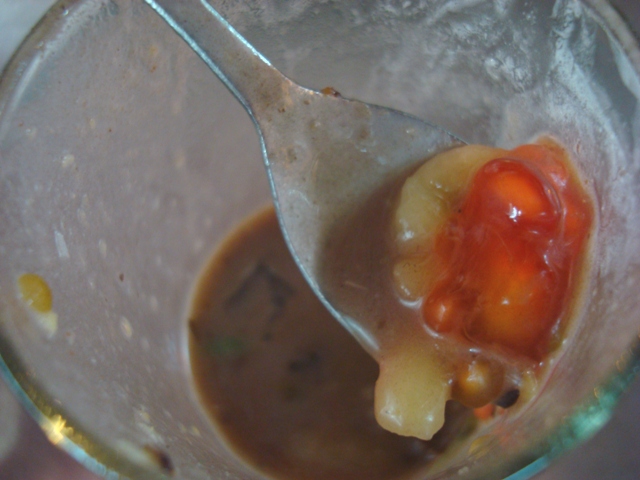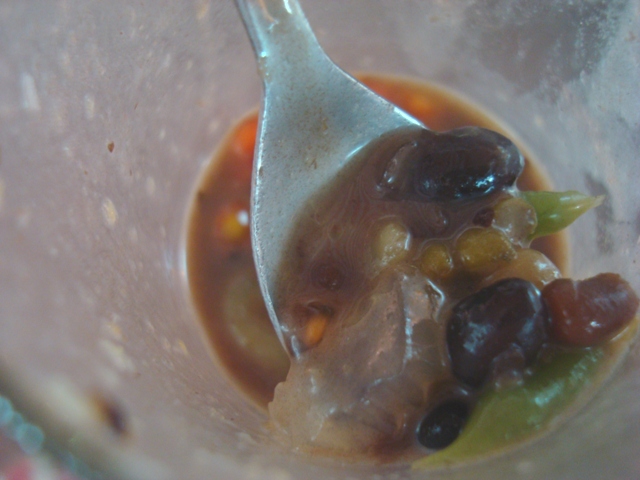
Chè, Dessert In A Glass - The Dropout Diaries
Chè, Dessert In A Glass
Pronounced with a falling or down tone, the Vietnamese chè is the name of a range of desserts that appear quite daunting at first.
Not to be mistaken for any kind of relation to Che Guevara, the Argentine revolutionary, Vietnamese chè is often translated as “sweet soup”. An avid soup-lover myself, the sweet soup translation never really tickled my fancy.

My Vietnamese colleagues soon put me on the right track. Around the corner from the office was a small restaurant that specialised in chicken with sticky rice and chè. The sticky chicken dish was fairly average, in my opinion, but the chè was an absolute winner.
Soon I was sucking down chè like nobody’s business. Sago and banana chè. Lychee in syrup chè. Lotus seed chè. I tried all the healthy fruit varieties but I kept coming back to the creamy super-sweet versions, with various types of lentils and beans.
At first I couldn’t pronounce chè in a way that the vendors could understand. I carried a tattered scrap of paper in my purse inscribed with the words “chè ba màu”, my all-time favourite chè. Literally three-colour chè, chè ba màu is usually served in a glass, topped with ice. The colours are layered and there’s usually more than three. So you usually get a yellowish custard-like layer of what I’m told is green beans but I think is actually yellow split peas, a red layer of fake pomegranite seeds, a layer of dark lentils and a layer of creamy coconut cream. I like the version pictured below that has a layer of green jelly snakes too.
My chè is usally gone before the nearest friendly Vietnameses speaker can finish explaining what the various ingredients are. There’s a lot of sugar syrup, for sure.
At first the concept of eating lentils and the beans used in baked beans in a dessert didn’t sit right with me. But the more I relaxed and the more chè I ate, the more it started to seem natural in a comfort-food kind of way.
Unfortunately, as most budding artists discovered at the age of three, mixing beautiful colours together results in a purple-brown sludge. But chè does taste best all mixed up.

Sitting on an aluminium stool, leaning over a sticky aluminum table, with traffic whizzing past, decripit lottery sellers tapping you on the shoulder, drunk guys bumping your back, giggly school girls squirming against your elbow, the vendor yelling across your head at his wife … ah, is there a more romantic setting for a dessert date? Probably. But this is Vietnam, which has a surplus of noise and people and joy. And fantastic food.
Chè, eaten on the street, is to me a lovers’ dessert. But not when your darkly handsome man orders chè Thai Lan, which includes durian. (The Vietnamese word for Thailand is Thai Lan, which actually sounds like Thai Lang.)
If you have never tasted durian, take it from me, it’s like fart-flavoured custard. And fart flavour is not what a Westerner wants in a dessert. Or in a post-dessert kiss.

I love chè so much that I order it without ice. Ice just dilutes the taste… and slows me down. (I’m shocking, I know.)
There’s also warm chè, which seems to be more of a restaurant thing. I can’t say no to chè chuối chưng, a warm pudding of banana and sago pearls in coconut cream.
Similar gloopy soupy desserts are served throughout Asia. They have different names but take it from me, they must be tried, even if you don’t like lentils or lurid colours in your food. The Philippine halo halo comes with a purple taro icecream - yum-de-dum lip-smackingly good — and the Singaporean-Malay version is chendol, which comes with a fruit syrup.
However, I never did elicit much enjoyment from Vietnam’s seaweed chè. That may be connected to the bout of food poisoning I got, which was entirely unrelated to the street food seaweed chè I ate just prior to the first stomach pangs.
Editor’s note: Darling Man reckons if a Western says chair baa mao (baa like a sheep, mao like Mao Zedong) a vendor will understand. But I’m not wholly convinced.
My favourite che stall is at the Tan Dinh Market (Chợ Tân Định) at the far end of Hai Ba Trung Street in Ho Chi Minh City’s District 3. (The far end as in the end furtherest from the city.)
Breaking news: This post given an honourable mention over at suzyguese.com
Link nội dung: https://truyenhay.edu.vn/che-a38831.html